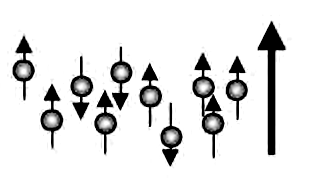
Magnetic Resonance Imaging (MRI)
 المؤلف:
Franklin Potter and Christopher Jargodzki
المؤلف:
Franklin Potter and Christopher Jargodzki
 المصدر:
Mad about Modern Physics
المصدر:
Mad about Modern Physics
 الجزء والصفحة:
p 82
الجزء والصفحة:
p 82
 29-10-2016
29-10-2016
 766
766
Magnetic Resonance Imaging (MRI)
Magnetic resonance imaging (MRI) is really the medical application of nuclear magnetic resonance, which physicists have been doing since the 1940s. A sample of living tissue contains numerous hydrogen atoms bound in molecules. Each hydrogen nucleus has a spin with a magnetic moment that can be aligned by an applied magnetic field. The sample is placed in a very strong uniform magnetic field to align the spins of the hydrogen nuclei. A pulsed electromagnetic field is applied that would flip just one hydrogen spin, for example. What alternative QM interpretation can one provide that treats the nuclei as a collective whole?

Answer
Nuclear magnetic resonance experiments began in the 1940s, and they continue to be very useful today. Their alternative QM behavior is described as a collection of spins acting together. Initially, the spin collection has a total spin S in a collective quantum state Ψ = ψ1 + ψ2 + ψ3 + . . . and then the pulsed magnetic field rotates them all so slightly to S – α with respect to the original direction that is, they act collectively and coherently. No one spin behavior is isolated from the others in the same microscopic atomic environment. All hydrogen nuclei in the same environment respond the same, while those in a different environment respond slightly differently.
The MRI instrument for magnetic resonance imaging uses the differences in the microscopic atomic environment to allow different regions of the living tissue to be “seen” separately. A computer algorithm analyzes the data from numerous RF detectors surrounding the body and constructs an artificial image on a display screen. A dynamic MRI instrument has a fast response time to show changes occurring in the microscopic environment in seconds or less, such as muscle action or heart contractions.
 الاكثر قراءة في طرائف الفيزياء
الاكثر قراءة في طرائف الفيزياء
 اخر الاخبار
اخر الاخبار
اخبار العتبة العباسية المقدسة


